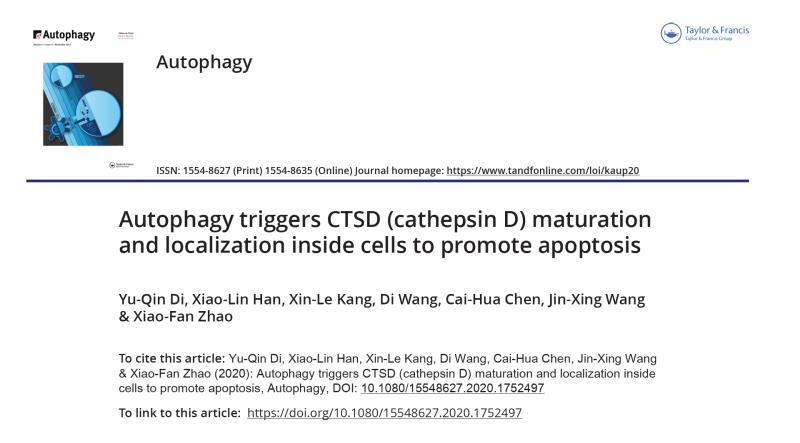CTSD/CathD/CATD (cathepsin D) is a lysosomal aspartic protease that digests discarded proteins in lysosomes to maintain cell health. CTSD also has dual functions of pro-apoptotic and pro-proliferation under different physiological and pathological conditions, i.e., entering the cytosol in a mature form (m-CTSD), causing apoptosis to extracellular in a pro-enzyme (pro-CTSD) and promoting cell proliferation. Hence, the expression, maturation and secretion of CTSD are critical to its pro-apoptotic or pro-proliferative function, but its regulatory mechanism is unclear.During the metamorphosis from larva to adult, the complete metamorphosis insect undergoes the tissue remodeling process of larval tissue apoptosis and adult tissue proliferation under the regulation of molting hormone (20E), and its molecular mechanism is not clear.

Professor Zhao Xiaofan's team recently published an article in Autophagy entitled "autophagy stimulates cathepsin D maturation and intracellular localization to promote apoptosis." using cotton bollworm, a major agricultural pest, as a research model, to elucidate the molecular mechanism of molting hormone promoting CTSD expression, maturation and secretion during insect metamorphosis and its role in tissue remodeling of insect metamorphosis. Di Yuqin is the first author of the article, Professor Zhao Xiaofan is the corresponding author, and Shandong University is the affiliated unit. The research was supported by the National Natural Science Foundation of China.

The researchers revealed that the glycosylation of asparagine (N233) at position 233 determines the secretion of CTSD proenzyme (pro-CTSD). 20-hydroxyecdysone promotes CTSD expression and induces maturation by autophagy, leaving it in larval midgut cells and promoting the activation Caspase-3, thereby promoting larval midgut apoptosis. The proenzyme in the pupa epidermis is glycosylated (G-pro-CTSD) and released into the hemolymph to promote DNA replication and cell proliferation of adult fat bodies. This study reveals the molecular mechanisms of CTSD expression, maturation and secretion, the relationship between autophagy and apoptosis and transformation mechanisms, and the molecular mechanisms of the fate of different tissues and cells in the tissue remodeling of insect metamorphosis and development. It provides theoretical reference for the development of strategies to regulate CTSD dual function to promote apoptosis or proliferation, and provides target genes for pest control, which has important theoretical and practical value.
Written by:Gong Jing
Edited by: Che Huiqing